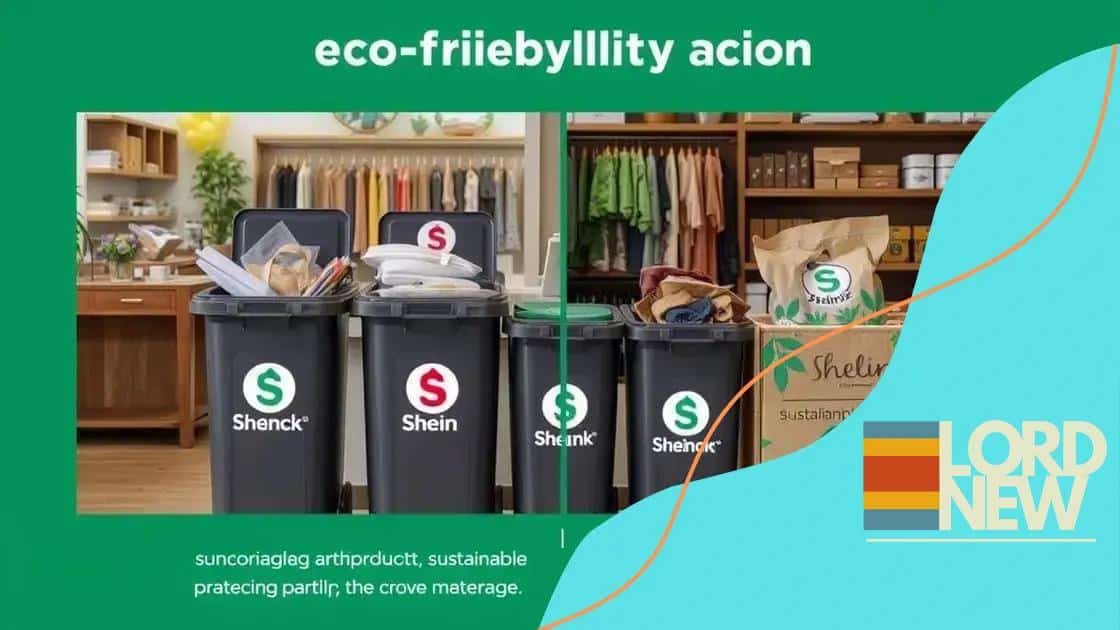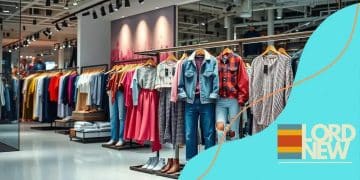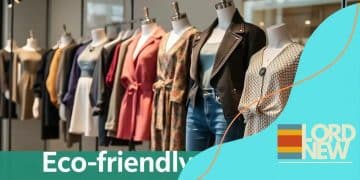How Shein balances affordability and eco-friendliness

Shein balances affordability and eco-friendliness by adopting sustainable materials and practices while leveraging efficient production techniques to keep costs low, meeting consumer expectations for both style and responsibility.
How Shein balances affordability and eco-friendliness is a question many ponder. With their expansive product line, they have captured a significant market share, but how do they do it sustainably? Let’s dive in.
Understanding Shein’s business model
Understanding Shein’s business model is essential to grasp how the brand maintains its status as a leading player in fast fashion. This model blends affordability and trendiness, delivering products that cater to various consumer demands. Shein quickly identifies emerging trends, enabling them to offer fashionable items at low prices.
Key Components of Shein’s Business Model
Several key components drive Shein’s success:
- Data-Driven Insights: Shein utilizes data analytics to assess consumer preferences and purchasing behavior. This approach allows the company to stock items that are more likely to sell.
- Efficient Supply Chain: Their agile supply chain ensures rapid production and distribution, keeping pace with the fast-moving fashion trends.
- Direct-to-Consumer Sales: By prioritizing online sales, Shein minimizes operating costs and passes savings on to customers.
- Global Reach: Operating in numerous countries, Shein caters to diverse markets, expanding their customer base rapidly.
This combination of agility and customer-centric strategies allows Shein to remain relevant and competitive in the global fashion industry. Their business model emphasizes responsiveness to consumer feedback, facilitating quick adjustments in offerings.
Sustainability Considerations
While affordability is a primary focus, Shein also addresses sustainability. Recent initiatives aim to incorporate eco-friendly practices into their operations, appealing to a more environmentally conscious audience. Such measures include:
- Reducing Waste: Shein is exploring strategies to minimize fabric scraps and other waste in the production process.
- Recycling Programs: The company is planning initiatives to encourage customers to recycle old clothing.
- Eco-Friendly Materials: Shein is investing in research to use more sustainable fabrics in their collections.
This dynamic approach, balancing affordability with emerging sustainability trends, highlights how Shein adapts its business model. As consumer expectations evolve, Shein continues to innovate, striving for success in both environmental and market spheres.
The importance of affordability
The importance of affordability in fashion cannot be overstated. For many consumers, price is a significant factor when choosing where to shop. In this competitive market, brands like Shein thrive by offering a wide range of products at accessible prices. This approach attracts budget-conscious shoppers who are keen to stay stylish without overspending.
Why Prices Matter
Affordability influences shopping habits in several ways:
- Accessibility: Lower prices open doors for more consumers, allowing them to explore various styles and trends.
- Increased Sales: When consumers find products within their budget, companies like Shein see higher sales volumes.
- Brand Loyalty: Offering affordable options can lead to repeat customers who return for more.
- Trend Engagement: Consumers are eager to purchase trending items when prices are kept low, allowing them to refresh their wardrobes frequently.
This focus on affordability helps brands like Shein capture attention in the crowded marketplace. The ability to provide trendy apparel at reasonable prices aligns with consumer desires, making it easier for shoppers to mix and match styles.
Balancing Quality and Price
Maintaining a balance between affordability and quality is essential for Shein. While low prices attract customers, product quality plays a crucial role in customer satisfaction. Shein strategically invests in materials and production techniques to ensure their products are not just inexpensive, but also worth the investment.
Additionally, brands are now shifting towards a value-based pricing model. This means they consider the perceived value of their items alongside production costs. When consumers see quality at a good price, they are more likely to make a purchase. This balance fosters a positive shopping experience and encourages consumers to return for future purchases.
Eco-friendly practices at Shein

Eco-friendly practices at Shein have become a significant focus as the brand seeks to improve its sustainability efforts. With the growing demand for sustainable fashion, Shein is taking steps to address environmental concerns. The company’s initiatives aim to make their production processes greener while still providing affordable clothing.
Implementing Sustainable Materials
One of the key areas where Shein is making changes is in the selection of materials. By incorporating more sustainable fabrics, the brand hopes to reduce its environmental impact. Some materials they are exploring include:
- Recycled Polyester: Made from recycled plastics, this fabric helps to reduce waste and lower carbon emissions.
- Organic Cotton: Grown without synthetic pesticides, organic cotton is better for the environment and can be more sustainable than conventional cotton.
- Eco-Friendly Dyes: Using dyes that are less harmful to the ecosystem minimizes pollution in the water supply.
These materials not only contribute to a healthier planet but also resonate with environmentally conscious consumers.
Reducing Waste
Another crucial aspect of Shein’s eco-friendly approach focuses on waste reduction. The brand is adopting various strategies to minimize waste throughout its supply chain. This includes:
- On-Demand Production: By producing items only after they are ordered, Shein limits overproduction and reduces excess inventory.
- Packaging Innovations: Shein is investigating ways to use less packaging or switch to biodegradable options.
These steps reflect a commitment not just to affordability but also to sustainable practices that help lessen their environmental impact. Shein understands that consumers are increasingly prioritizing eco-friendly choices and are eager to align their offerings with these values.
Community Initiatives
Shein is also engaging in community-driven environmental initiatives. Collaborating with charitable organizations helps them to promote sustainability awareness among consumers. This involvement encourages shoppers to think more critically about their purchasing habits and the environmental consequences associated with fast fashion.
In summary, Shein’s eco-friendly practices demonstrate a willingness to evolve and adapt to the changing demands of consumers. By focusing on sustainable materials, waste reduction, and community involvement, Shein aims to create a more responsible fashion industry.
Consumer perceptions of sustainability
Consumer perceptions of sustainability play a vital role in shaping today’s fashion industry. As shoppers become more aware of environmental issues, their expectations from brands are changing. They seek transparency and responsibility in the products they buy, especially from fast-fashion retailers like Shein.
Growing Awareness
More consumers are becoming conscious of how their choices impact the planet. This awareness fosters a desire for sustainable practices in the brands they support. Additionally, they are eager to understand where materials come from and how garments are produced. The shift in mindset encourages shoppers to make informed decisions based on environmental responsibility.
Expectations from Brands
Today’s consumers often expect brands to engage in sustainable practices. When considering a purchase, they look for:
- Transparency: Clear information about material sourcing and manufacturing processes is vital.
- Eco-Friendly Products: Consumers prefer items made from sustainable materials and those designed to minimize waste.
- Corporate Responsibility: Many shoppers want brands to contribute positively to their communities and the environment.
This shift towards sustainability affects how brands like Shein strategize their marketing and production processes. Understanding consumer expectations helps them cater to growing demands for responsibility.
Impact on Buying Decisions
As awareness of sustainability rises, it directly influences buying decisions. Many consumers are willing to pay more for products that align with their values. They reconcile the balance between affordability and eco-friendliness by seeking brands that offer both. This trend highlights a preference for companies that keep sustainability in mind while ensuring prices remain accessible.
Furthermore, consumers often share their views and experiences on social media, amplifying their voices. Positive feedback for brands implementing sustainable practices can lead to increased brand loyalty. This word-of-mouth promotion can significantly impact a brand’s reputation and sales.
Future challenges in balancing cost and eco-friendliness
Future challenges in balancing cost and eco-friendliness present significant hurdles for fast-fashion brands like Shein. As consumer expectations shift toward sustainability, these companies must find ways to maintain low prices while improving their environmental impact.
Cost Management
One of the primary challenges is managing production costs. Sustainable materials often come at a higher price, making it difficult for brands to keep product costs low. Shein must explore more cost-effective sustainable practices, such as:
- Bulk Purchasing: Buying materials in larger quantities can reduce costs per unit.
- Innovative Production Techniques: Investing in technology that improves efficiency can help lower production costs.
- Supplier Partnerships: Collaborating with suppliers who focus on sustainability might provide better pricing options.
These strategies can help mitigate the financial impact of using sustainable materials.
Consumer Expectations
As consumers become increasingly environmentally conscious, their expectations for brands continue to rise. This shift can create pressure on companies to implement rapid changes. However, maintaining affordability is crucial. Brands like Shein face the challenge of meeting customer demands for a more sustainable approach without alienating price-sensitive shoppers.
To navigate this, brands can focus on effective communication. By educating consumers about the benefits of sustainability and why prices may vary, they can foster understanding and support. Sharing stories of positive environmental impacts can also engage consumers and encourage them to prioritize sustainable options.
Regulatory Pressures
Additionally, regulatory bodies are implementing stricter environmental standards. Brands must adapt to these changes while keeping production costs manageable. This might involve investments in new technologies and practices that align with regulations, which could be costly in the short term.
Understanding these regulatory frameworks is crucial for brands to remain compliant while seeking eco-friendly alternatives. This proactive approach helps ensure brands like Shein can continue to thrive in an evolving marketplace.
FAQ – Sustainability and Affordability in Fashion
How does Shein manage to keep prices low while being eco-friendly?
Shein uses innovative production techniques and bulk purchasing of sustainable materials to minimize costs while adopting eco-friendly practices.
What are consumers looking for regarding sustainable fashion?
Consumers increasingly seek transparency about materials and production processes, as well as eco-friendly products that align with their values.
What challenges do brands face when trying to be sustainable?
Brands must balance the higher costs of sustainable materials with the demand for affordable prices, all while meeting consumer expectations.
How can consumers influence brands to adopt better practices?
Consumers can engage through feedback and support brands that prioritize sustainability, encouraging them to improve their practices and offerings.





